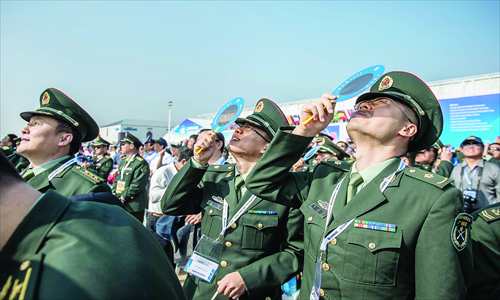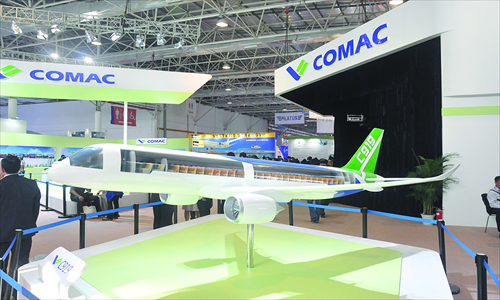Aircraft orders take off


Airshow China 2012 saw Tuesday new purchase agreements being inked for the country's large passenger aircraft and the first deal made for its advanced trainer jet.
Purchase agreements for a total of 50 C919 passenger aircraft between manufacturer Commercial Aircraft Corporation of China Ltd (COMAC) and General Electric Capital Aviation Services, Joyair and Hebei Aviation Group were the highlight of the show's opening day in Zhuhai, Guangdong Province.
With new customers on board, the C919, a 150-seat class narrow-body airliner designed to deliver a 10 percent reduction in operation costs compared with its Boeing 737 and Airbus A320 rivals, has received a total of 380 orders so far. US company Eastern Airlines also signed a memorandum of understanding to purchase the plane on Tuesday.
Tian Ming, chief accountant of COMAC, said after the signing ceremony that Chinese and world markets will require 4,000 and 20,000 new 150-seater planes respectively over the next 20 years.
"COMAC's strategy is to focus on the domestic market while trying to explore overseas," he said. "Progress has been in accordance with established plans and the C919 will make its maiden flight in 2014 and be delivered to customers in 2016," he added.
However, Aviation Week quoted industry sources as saying that though the C919 program reached its halfway mark this year, and has already used up all available spare time in its timetable. This means there will be no room for delay if the C919 is to meet its maiden flight deadline.
The delivery of COMAC's ARJ-21 regional jet, a program deemed as being a prelude to China's large passenger aircraft, was delayed from 2007 to 2013 due to various difficulties.
In the field of military aviation, the first contract to buy 12 L-15s, an advanced two-engine supersonic trainer aircraft, was signed between Aviation Industry Corporation of China Hongdu (AVIC Hongdu) and the China National Aero Technology Import & Export Corporation.
Since the intended end-user of the L-15s was not revealed at Tuesday's ceremony, the contract implied a milestone for China's military aviation export eforts. Previously, the only aircraft incorporating fourth-generation fighter technologies that had been successfully exported was the Chengdu FC-1/JF-17 Thunder, a lightweight fighter co-developed by China and Pakistan and only exported to the latter.
Li Yuhai, vice general president of the Aviation Industry Corporation of China (AVIC), said the L-15 was an old friend of the Airshow China. It made its public debut in Zhuhai in 2004 and has performed two aerobatic displays there since. "It is the Airshow that gave birth to L-15's first deal. Several countries have clearly expressed their intention to purchase it after the show," Li said.
For many spectators, the most eye-catching exhibit was a large-scale model of China's second stealth fighter dubbed as the J-31, which made its maiden flight on October 31.
The fighter, designed to deliver a stealth configuration at low cost, is under development for the international defense market, according to AVIC.
According to Aviation Week, the fighter has a heavy load capability over a wide combat radius and is therefore almost equivalent to most typical fifth generation fighters.
Also on Tuesday, China's defense and aerospace industry showcased its latest products for export.
The China Aerospace Science and Industry Corporation and the China Aerospace Science and the Technology Corporation displayed the LY-80, FD-2000 and C-602, which are export versions of the most advanced air and coastal defense missile systems available to the People's Liberation Army.
Some exhibits have already attracted foreign customers, including the FD-2000 long-range air defense missile and the CH-4 multi-role Unmanned Aerial Vehicle (UAV).
"We developed the new UAV based on foreign orders and will cater to both domestic and foreign markets," said Huang Wei, program supervisor of the CH-4 UAV.
Zong Wenbo, vice dean of the Shanghai Academy of Spaceflight Technology and the developer of the LY-80 mid-range air defense missile, told the Global Times that the academy highly valued the export market.
"Though Chinese users frequently conduct live fire drills with our missile, it is crucial for us to receive feedback from foreign users and see how our system works in real combat situations," he said.
Outside the exhibition halls, aerobatic teams from different countries took turns to perform stunts over Zhuhai airport.
Read more in Daily Specials